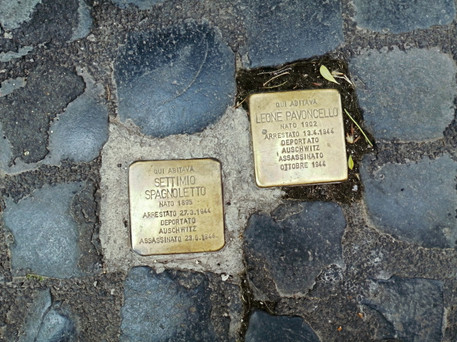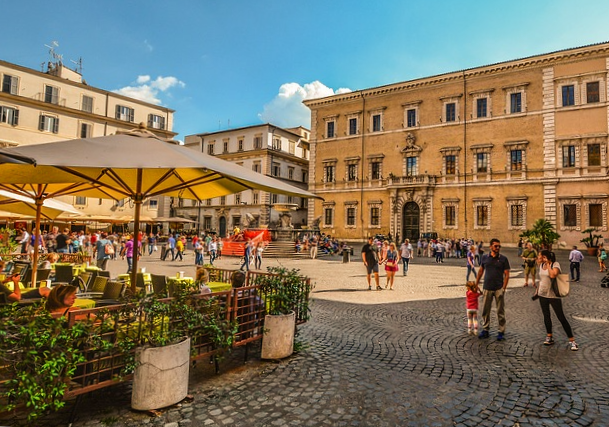A guide to my favourite neighbourhoods in Rome
- Emma
- Apr 16, 2022
- 4 min read
With a little over a week left in Rome, I want to share with you my favourite neighbourhoods in the city. I've been all over the place to find galleries, resteraunts and communities outside of the usual tourist trail. If you're in Rome at all, I really recommend you visit a few of my favourite districts:
Jewish Ghetto
If you're looking to explore a traditional neighborhood but your strapped for time, the Jewish Ghetto is a 10 minute walk from attractions like the Pantheon. The Jewish Quarter is famous for its traditional cuisine (think less pasta and more meats, artichokes and fish) ancient ruins, and a water fountain in every piazza. The neighbourhood has a quieter, reverant atmosphere than the rest of the city centre, no doubt due to the history it's residents becoming victims to fascism and the holocaust; which is memorialised through c.300 'pietri d’inciampo'. Italian for “stumbling stone", you’ll find many of the bronze plaques in the cobbles outside doorways, sometimes grouped together with one stone for each member of a family lost to the holocaust.
Tor Marancia

Tor Marancia requires a little more motivation to get to (or knowledge of the bus system) but it is well worth it to see a collection of professional murals. Take the 160 bus from Circo Massimo (or Piazza Venezia, Barberini and many other central spots) for 15 minutes to Tor Marancia/ Arcadia where it will drop you off right in front of the street art quarter. If you don't want to brave the bus map, get off at Basilica S. Paolo metro stop and enjoy a half hour stroll through quiet Ostiense. Head to this neighbourhood if you're spending more than a week in Rome, and you can enjoy half a day enjoying the public art, or give more time if you want to climb as far as the catacombs on the Appian Way.
Pigneto
When people tell you to go to Trastevere for the alternative scene, go to Pigneto. This authentic alternative neighbourhood boasts pretty old streets, street art and fantastic eateries. Pigneto is easy to get to by taking the new green metro line. For food, get off at the Pigneto metro stop and head west to Via del Pigneto for food and drinks. For gelato, visit Tempesta Di Gusti near the metro station, then head back on yourself to the west of Via Braccio da Montone and walk eastwards past old terraced houses and street art. Stop at Necci dal 1924 for lunch or apertivo and jazz on the shady terrace. For record stores, try Bluetopia and for vintage clothes shops, try Mademoiselle Vintage. If you visit in the early afternoon like me, you might find that some businesses have closed for a long lunch. I would suggest the best time to visit the neighbourhood is early evening, and apparently the area is good for gigs at venues like Fanfulla 5/a.
Policlinico & San Lorenzo
These pretty neighbourhoods east of the main Termini train station could be easily overlooked for their flashier central counterparts. Typically inhabited by students, artists and young families, both Policlinico and San Lorenzo are relatively weathly, clean districts where you can expect to find flower sellers outside the Quadriportico Verano Cemetary (which in itself is beautiful and worth a visit). Better than that, San Lorenzo is home to reputabley the best chocolatier in Rome, SAID dal 1923. I was lucky enough to pop in before Easter where the endlessly friendly shop assistants helped me choose an artisan (and reasonably priced!) Easter egg and Colomba cake. If you're in the area, you may also want to visit the Fondazione Pastificio Cerere art gallery, which houses several artist studios and exhibits contemporary art within a former pasta factory.
Flaminio & Pinciano
Best visited on a warm Sunday afternoon, Flaminio is a popular neighbourhood close to the Piazza del Popolo, Borghese Gallery and the National Gallery of Modern and Contemporary Art. A good weekend looks like taking the metro to Flaminio and heading straight to the Borghetto Flaminio Market-only open Sundays. Entry is €1.60 but it's more than worth it for the vintage treasures and authentic designer labels, usually sold by wealthier store holders from close-by Prati. If your keen on contemporary arts (particularly architecture or film/photography) take the tram from Via Flaminia to the MAXXI Museum. Otherwise, head back down to the piazza before taking the stairs left up to the Borghese Gardens. Enjoy the view from the top of the Terrazza del Pincio and enjoy the park (there's cafes and buggies to rent). Borghese Gardens are were you will find the Romans enjoying the sun on their days off. At the top of the garden are the museums, pay a visit or walk down the east side of the gardens to the Spanish Steps. Flaminio is right next door to the main shopping quarter. You can find high-end labels closest to the steps and high street brands a couple streets away.
Cavour

Cavour sparkles in the evening. Pronouced 'Cav-or-uh', the district is visited by plenty of tourists, but for good reason. Close to the Colosseum, it's great for independent shopping, art galleries and pop-up craft markets. The restaurants away from the main roads are authentic and reasonably priced. In the evening, Cavour really comes alive at night for apertivo, roof top bars and jazz cafes. Slip away from busy Via Cavour to Via delgi Zingari for better restaurants and a social atmosphere.
Trastevere
Trastevere's reputation as the 'little known trendy neighbourhood' has earned it a #8 spot in 'Things to Do in Rome' on TripAdvisor. You won't see many actual Italians in this district but that's not to say it shouldn't be visited. Easy to walk to from the city centre, the piazzas are lined with coffee bars and apertivo spots. Buskers play on almost every corner and the best pizza and focaccia can be found up traditional terraced alleys. Watch out for the usual tourist scams in this busy slice of gastro paradise.
I might be writing a few more of these general 'must see' blogs, as they give more of a flavour for the real Rome. On the list are my favourite markets, food spots and a post on Rome's birthday celebrations (21st April). Stay tuned :)



































Comments